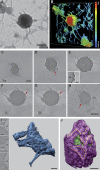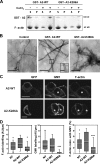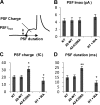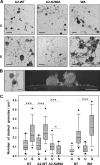Annexin A2-dependent actin bundling promotes secretory granule docking to the plasma membrane and exocytosis
- PMID: 26323692
- PMCID: PMC4555831
- DOI: 10.1083/jcb.201412030
Annexin A2-dependent actin bundling promotes secretory granule docking to the plasma membrane and exocytosis
Abstract
Annexin A2, a calcium-, actin-, and lipid-binding protein involved in exocytosis, mediates the formation of lipid microdomains required for the structural and spatial organization of fusion sites at the plasma membrane. To understand how annexin A2 promotes this membrane remodeling, the involvement of cortical actin filaments in lipid domain organization was investigated. 3D electron tomography showed that cortical actin bundled by annexin A2 connected docked secretory granules to the plasma membrane and contributed to the formation of GM1-enriched lipid microdomains at the exocytotic sites in chromaffin cells. When an annexin A2 mutant with impaired actin filament-bundling activity was expressed, the formation of plasma membrane lipid microdomains and the number of exocytotic events were decreased and the fusion kinetics were slower, whereas the pharmacological activation of the intrinsic actin-bundling activity of endogenous annexin A2 had the opposite effects. Thus, annexin A2-induced actin bundling is apparently essential for generating active exocytotic sites.
© 2015 Gabel et al.
Figures









Similar articles
-
Annexin A2, an essential partner of the exocytotic process in chromaffin cells.J Neurochem. 2016 Jun;137(6):890-6. doi: 10.1111/jnc.13628. Epub 2016 May 25. J Neurochem. 2016. PMID: 27037794 Review.
-
Annexin 2 promotes the formation of lipid microdomains required for calcium-regulated exocytosis of dense-core vesicles.Mol Biol Cell. 2005 Mar;16(3):1108-19. doi: 10.1091/mbc.e04-07-0627. Epub 2005 Jan 5. Mol Biol Cell. 2005. PMID: 15635098 Free PMC article.
-
S100A10-mediated translocation of annexin-A2 to SNARE proteins in adrenergic chromaffin cells undergoing exocytosis.Traffic. 2010 Jul 1;11(7):958-71. doi: 10.1111/j.1600-0854.2010.01065.x. Epub 2010 Apr 1. Traffic. 2010. PMID: 20374557
-
Phosphorylation cycling of Annexin A2 Tyr23 is critical for calcium-regulated exocytosis in neuroendocrine cells.Biochim Biophys Acta Mol Cell Res. 2019 Jul;1866(7):1207-1217. doi: 10.1016/j.bbamcr.2018.12.013. Epub 2019 Jan 2. Biochim Biophys Acta Mol Cell Res. 2019. PMID: 30610889
-
Mechanisms of secretory granule transport and exocytosis in anterior pituitary cells.Ital J Anat Embryol. 1995;100 Suppl 1:219-29. Ital J Anat Embryol. 1995. PMID: 11322296 Review.
Cited by
-
Impaired migratory phenotype of CD4+ T cells in Parkinson's disease.NPJ Parkinsons Dis. 2022 Dec 10;8(1):171. doi: 10.1038/s41531-022-00438-0. NPJ Parkinsons Dis. 2022. PMID: 36496415 Free PMC article.
-
The Annexin A2/S100A10 Complex: The Mutualistic Symbiosis of Two Distinct Proteins.Biomolecules. 2021 Dec 9;11(12):1849. doi: 10.3390/biom11121849. Biomolecules. 2021. PMID: 34944495 Free PMC article. Review.
-
Molecular characterization and functional implications on mouse peripheral blood mononuclear cells of annexin proteins from Echinococcus granulosus sensu lato.Parasit Vectors. 2023 Oct 6;16(1):350. doi: 10.1186/s13071-023-05967-y. Parasit Vectors. 2023. PMID: 37803469 Free PMC article.
-
Visualization of Membrane Pore in Live Cells Reveals a Dynamic-Pore Theory Governing Fusion and Endocytosis.Cell. 2018 May 3;173(4):934-945.e12. doi: 10.1016/j.cell.2018.02.062. Epub 2018 Apr 5. Cell. 2018. PMID: 29606354 Free PMC article.
-
Multiple Roles of Actin in Exo- and Endocytosis.Front Synaptic Neurosci. 2022 Mar 4;14:841704. doi: 10.3389/fnsyn.2022.841704. eCollection 2022. Front Synaptic Neurosci. 2022. PMID: 35308832 Free PMC article. Review.
References
Publication types
MeSH terms
Substances
LinkOut - more resources
Full Text Sources
Other Literature Sources
Molecular Biology Databases

